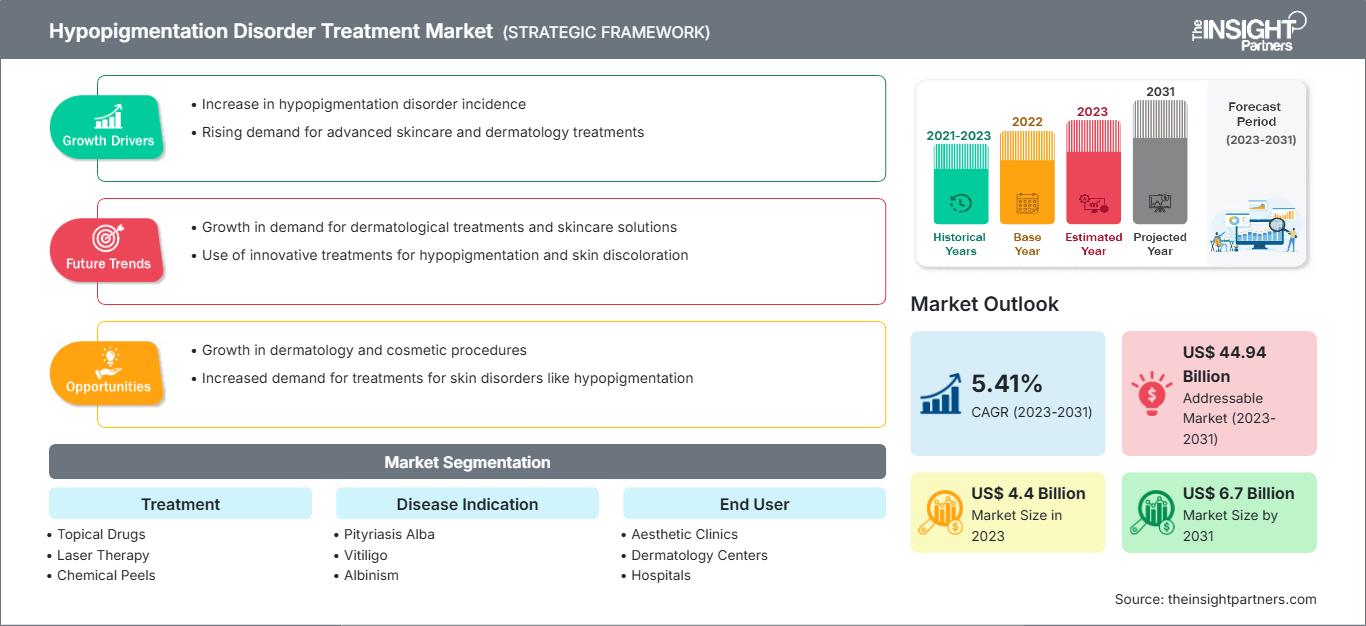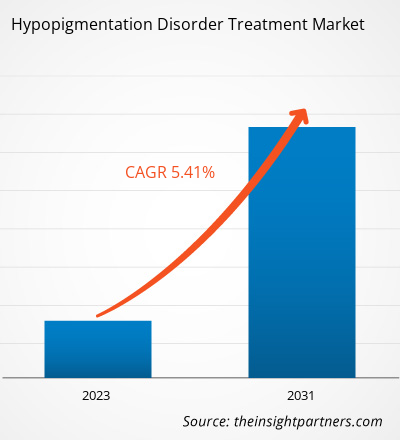[Forschungsbericht] Der Marktwert für die Behandlung von Hypopigmentierungsstörungen wird voraussichtlich von 4,4 Milliarden US-Dollar im Jahr 2023 auf 6,7 Milliarden US-Dollar im Jahr 2031 steigen; der Markt wird voraussichtlich zwischen 2023 und 2031 eine durchschnittliche jährliche Wachstumsrate (CAGR) von 5,41 % verzeichnen.
Markteinblicke und Analystenmeinung:
Hypopigmentierungsstörungen können sich zu Depigmentierungsstörungen entwickeln. Dabei handelt es sich um einen Zustand, bei dem der Pigmentgehalt der Haut unter dem Optimum liegt, im Gegensatz zu Depigmentierungszuständen, die durch die vollständige Entfernung von Pigmenten entstehen. Wichtige Faktoren, die das Marktwachstum bei der Behandlung von Hypopigmentierungsstörungen vorantreiben, sind das steigende Bewusstsein für Hypopigmentierungsstörungen, technologische Fortschritte in der ästhetischen Behandlung und die kontinuierliche Alterung der Bevölkerung. Darüber hinaus wird erwartet, dass die zunehmende Zahl hypopigmentierungsbedingter Erkrankungen wie Albinismus, Posthypopigmentierung und Vitiligo den Markt für die Behandlung von Hypopigmentierungserkrankungen in den kommenden Jahren ankurbeln wird. Steigende Verbraucherausgaben für Hautgesundheit und ein höheres Behandlungsbewusstsein dürften diesem Markt in naher Zukunft ebenfalls zugutekommen. Die Einführung natürlicher und pflanzlicher Inhaltsstoffe dürfte in den kommenden Jahren neue Markttrends für die Behandlung von Hypopigmentierungserkrankungen mit sich bringen, da diese Produkte bislang entscheidend zur Deckung der weltweiten Nachfrage nach Cosmeceuticals beigetragen haben. Die Kosten für kosmetische Behandlungen und Operationen schränken hingegen das Marktwachstum ein.
Laut dem Register National Clinical Trials (NCT) hat die Incyte Corporation im Juni 2020 eine klinische Phase-II-Studie zu Ruxolitinib durchgeführt, um dessen Sicherheit und Wirksamkeit bei der Behandlung von Vitiligo bei in den USA teilnehmenden Probanden zu untersuchen. Daher ist die steigende Zahl klinischer Studien zu Hypopigmentierungsstörungen ein weiterer wichtiger Faktor, der den Markt stärkt.
Wachstumstreiber und Herausforderungen:
Zunehmende Prävalenz von Hypopigmentierungsstörungen treibt Marktwachstum an
Pityriasis alba, Vitiligo, Albinismus und postinflammatorische Hypopigmentierung gehören zu den wichtigsten Krankheitsindikationen im Zusammenhang mit Hypopigmentierungsstörungen. Vitiligo ist eine weltweit häufig auftretende Krankheitsindikation. Laut einer im Dezember 2023 in Dermatology Practical and Conceptual veröffentlichten Studie ist Vitiligo eine weit verbreitete Hauterkrankung, die beide Geschlechter betrifft. Dennoch tritt sie häufiger bei Frauen auf, und bei über 60 % der Patienten beginnt die Krankheit vor dem 30. Lebensjahr. Es wird erwartet, dass die steigende Inzidenz und Prävalenz von Vitiligo die Nachfrage nach Hypopigmentierungsbehandlungen weiter steigern wird.
Laut einem im März 2023 im Zagazig University Medical Journal veröffentlichten Artikel sind Hypopigmentierungsstörungen eine häufige Gruppe von Dermatosen in der Pädiatrie; die Prävalenz von Hypopigmentierungsstörungen variiert von Land zu Land und liegt zwischen 3,6 % und 9,9 %. Darüber hinaus waren das Aufkommen und die Einführung minimalinvasiver Verfahren, kürzere Krankenhausaufenthalte sowie geringere Schmerzen und Komplikationen im Zusammenhang mit den Verfahren ausschlaggebend für die wachsende Beliebtheit minimalinvasiver Verfahren. Laut der American Society of Plastic Surgeons (ASPS) ist die Zahl minimalinvasiver kosmetischer Eingriffe in den USA seit dem Jahr 2000 im Jahr 2021 um fast 200 % gestiegen. Die zunehmende Präferenz für minimalinvasive kosmetische Eingriffe treibt das Marktwachstum für die Behandlung von Hypopigmentierungsstörungen weiter voran. Andererseits sind die Kosten für Lichttherapie bei Krankheitsindikationen wie Vitiligo und Albinismus hoch. Darüber hinaus sind chirurgische Eingriffe zur Behandlung von Vitiligo sehr teuer. Die hohen Kosten der Behandlungen schränken daher ihre Akzeptanz ein und hemmen damit das Wachstum des Marktes für die Behandlung von Hypopigmentierungsstörungen.
Passen Sie diesen Bericht Ihren Anforderungen an
Sie erhalten kostenlos Anpassungen an jedem Bericht, einschließlich Teilen dieses Berichts oder einer Analyse auf Länderebene, eines Excel-Datenpakets sowie tolle Angebote und Rabatte für Start-ups und Universitäten.
Markt für die Behandlung von Hypopigmentierungsstörungen: Strategische Einblicke

-
Holen Sie sich die wichtigsten Markttrends aus diesem Bericht.Dieses KOSTENLOSE Beispiel umfasst Datenanalysen, die von Markttrends bis hin zu Schätzungen und Prognosen reichen.
Segmentierung und Umfang des Berichts:
Die Marktanalyse zur Behandlung von Hypopigmentierungsstörungen wurde unter Berücksichtigung der folgenden Segmente durchgeführt: Behandlung, Krankheitsindikation und Endverbraucher. Der geografische Umfang des Marktberichts zur Behandlung von Hypopigmentierungsstörungen umfasst Nordamerika (USA, Kanada und Mexiko), Europa (Großbritannien, Deutschland, Frankreich, Italien, Spanien und übriges Europa), Asien-Pazifik (China, Japan, Indien, Australien, Südkorea und übriger Asien-Pazifik-Raum), den Nahen Osten und Afrika (VAE, Saudi-Arabien, Südafrika und übriger Naher Osten und Afrika) sowie Süd- und Südamerika. Mittelamerika (Brasilien, Argentinien und übriges Süd- und Mittelamerika).
Segmentanalyse:
Behandlungsbasierte Erkenntnisse
Basierend auf der Behandlung ist der Markt in topische Medikamente, Lasertherapie, chemische Peelings, Mikrodermabrasion, Phototherapie und andere segmentiert. Das Segment der topischen Medikamente hatte 2023 den größten Marktanteil bei der Behandlung von Hypopigmentierungsstörungen und wird voraussichtlich zwischen 2023 und 2031 die höchste durchschnittliche jährliche Wachstumsrate (CAGR) verzeichnen.
Krankheitsindikationsbasierte Erkenntnisse
Basierend auf der Krankheitsindikation ist der Markt für die Behandlung von Hypopigmentierungsstörungen in Pityriasis alba, Albinismus, Vitiligo, postinflammatorische Hypopigmentierung und andere segmentiert. Das Vitiligo-Segment hatte bis 2023 einen bedeutenden Marktanteil und wird voraussichtlich zwischen 2023 und 2031 die höchste CAGR verzeichnen.
Endnutzerbasierte Erkenntnisse
In Bezug auf den Endnutzer wird der Markt in Schönheitskliniken, dermatologische Zentren und Krankenhäuser unterteilt. Das Segment der Schönheitskliniken hatte 2023 den größten Marktanteil bei der Behandlung von Hypopigmentierungsstörungen; es wird außerdem erwartet, dass es zwischen 2023 und 2031 die höchste CAGR auf dem Markt verzeichnen wird.
Behandlung von Hypopigmentierungsstörungen
Regionale Einblicke in den Markt für die Behandlung von HypopigmentierungsstörungenDie Analysten von The Insight Partners haben die regionalen Trends und Faktoren, die den Markt für die Behandlung von Hypopigmentierungsstörungen im Prognosezeitraum beeinflussen, ausführlich erläutert. In diesem Abschnitt werden auch die Marktsegmente und die geografische Lage in Nordamerika, Europa, dem asiatisch-pazifischen Raum, dem Nahen Osten und Afrika sowie Süd- und Mittelamerika erörtert.
Umfang des Marktberichts zur Behandlung von Hypopigmentierungsstörungen
| Berichtsattribut | Einzelheiten |
|---|---|
| Marktgröße in 2023 | US$ 4.4 Billion |
| Marktgröße nach 2031 | US$ 6.7 Billion |
| Globale CAGR (2023 - 2031) | 5.41% |
| Historische Daten | 2021-2023 |
| Prognosezeitraum | 2023-2031 |
| Abgedeckte Segmente |
By Behandlung
|
| Abgedeckte Regionen und Länder |
Nordamerika
|
| Marktführer und wichtige Unternehmensprofile |
|
Dichte der Marktteilnehmer für die Behandlung von Hypopigmentierungsstörungen: Verständnis ihrer Auswirkungen auf die Geschäftsdynamik
Der Markt für die Behandlung von Hypopigmentierungsstörungen wächst rasant. Dies wird durch die steigende Nachfrage der Endverbraucher aufgrund veränderter Verbraucherpräferenzen, technologischer Fortschritte und eines stärkeren Bewusstseins für die Produktvorteile vorangetrieben. Mit der steigenden Nachfrage erweitern Unternehmen ihr Angebot, entwickeln Innovationen, um den Bedürfnissen der Verbraucher gerecht zu werden, und nutzen neue Trends, was das Marktwachstum weiter ankurbelt.

- Holen Sie sich die Markt für die Behandlung von Hypopigmentierungsstörungen Übersicht der wichtigsten Akteure
Regionale Analyse:
Nordamerika hatte 2023 den größten Anteil am Markt für die Behandlung von Hypopigmentierungsstörungen und wird voraussichtlich seine Dominanz (gemessen am Marktanteil) im Prognosezeitraum beibehalten. Die USA dominieren den Markt in dieser Region (mit dem größten Anteil) und weltweit. Eine gut ausgebaute Gesundheitsinfrastruktur, ein steigendes Bewusstsein der Menschen für ihre Hautgesundheit, die zunehmende Prävalenz von Krankheiten im Zusammenhang mit Hypopigmentierungsstörungen und eine bedeutende Präsenz von Unternehmen, die attraktive Behandlungsmöglichkeiten für Patienten mit postinflammatorischer Hyperpigmentierung anbieten, gehören zu den bemerkenswerten Faktoren, die das Marktwachstum in Nordamerika vorantreiben. Darüber hinaus zählen Schönheitsbedenken angesichts der steigenden Schönheitsstandards der Asiaten, eine große Zahl neu auf den Markt drängender Unternehmen und das anhaltende Wachstum etablierter Akteure zu den Hauptfaktoren, die zur Ausweitung des Marktes für die Behandlung von Hypopigmentierungsstörungen im asiatisch-pazifischen Raum beitragen.
Wettbewerbslandschaft und Schlüsselunternehmen:
Die Marktprognose für die Behandlung von Hypopigmentierungsstörungen kann den Akteuren dieses Marktes bei der Planung ihrer Wachstumsstrategien helfen. Allergan, SkinCeuticals, Pierre Fabre Group, Incyte Corporation, Episciences Inc., Phio Pharmaceuticals, Obagi Cosmeceuticals LLC, Alvogen, Bella Aurora und AbbVie sind einige der Schlüsselunternehmen, die im Marktbericht zur Behandlung von Hypopigmentierungsstörungen vorgestellt werden. Diese Unternehmen konzentrieren sich auf die Erweiterung ihres Produktangebots, um der wachsenden Verbrauchernachfrage weltweit gerecht zu werden. Ihre globale Präsenz ermöglicht es ihnen, ein breites Kundenspektrum zu bedienen.
- Historische Analyse (2 Jahre), Basisjahr, Prognose (7 Jahre) mit CAGR
- PEST- und SWOT-Analyse
- Marktgröße Wert/Volumen – Global, Regional, Land
- Branchen- und Wettbewerbslandschaft
- Excel-Datensatz
Aktuelle Berichte
Erfahrungsberichte
Grund zum Kauf
- Fundierte Entscheidungsfindung
- Marktdynamik verstehen
- Wettbewerbsanalyse
- Kundeneinblicke
- Marktprognosen
- Risikominimierung
- Strategische Planung
- Investitionsbegründung
- Identifizierung neuer Märkte
- Verbesserung von Marketingstrategien
- Steigerung der Betriebseffizienz
- Anpassung an regulatorische Trends






















 Kostenlose Probe anfordern für - Markt für die Behandlung von Hypopigmentierungsstörungen
Kostenlose Probe anfordern für - Markt für die Behandlung von Hypopigmentierungsstörungen